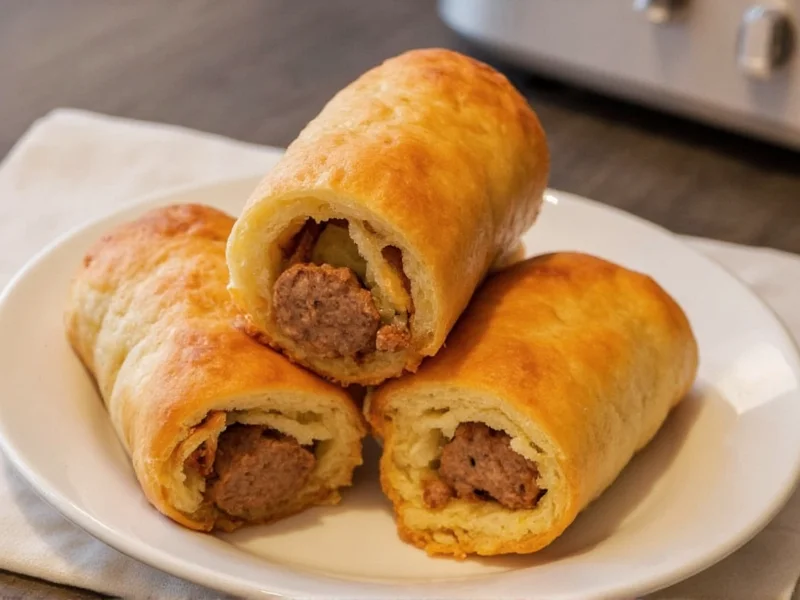The Essential Components of a Perfect Breakfast Sausage Roll
Creating an exceptional breakfast sausage roll requires attention to both the filling and pastry components. The sausage meat should contain at least 70% meat content with a balanced fat ratio (approximately 25-30%) for optimal juiciness. Traditional British breakfast sausage rolls use pork sausage meat seasoned with sage, thyme, nutmeg, and a touch of black pepper. Some regional variations incorporate apple, onion, or even a hint of Worcestershire sauce for depth of flavor.
The pastry component is equally critical. While some homemade breakfast sausage roll recipes use shortcrust pastry, authentic versions rely on quality puff pastry that creates those signature flaky layers. When selecting puff pastry, look for products with minimal additives and a high butter content. The best breakfast sausage roll ingredients always prioritize quality over convenience.
Step-by-Step Homemade Breakfast Sausage Roll Recipe
Follow this detailed method for creating professional-quality breakfast sausage rolls at home. This traditional British breakfast sausage roll recipe yields 8 substantial rolls that serve 4 people.
| Ingredient | Measurement | Notes |
|---|---|---|
| Quality puff pastry | 320g sheet | Chilled, preferably all-butter |
| Pork sausage meat | 500g | Minimum 70% meat content |
| Fresh sage | 2 tbsp, finely chopped | Essential for authentic flavor |
| Ground nutmeg | 1/4 tsp | Freshly grated preferred |
| Black pepper | To taste | Freshly cracked |
| Milk or egg wash | 2 tbsp | For golden finish |
Preparation Instructions
- Prepare the sausage filling by combining sausage meat, sage, nutmeg, and pepper in a bowl. Mix gently with hands until just combined (overmixing affects texture).
- Roll out the puff pastry on a lightly floured surface to approximately 30x20cm. Cut into two equal rectangles.
- Divide sausage meat into two portions and shape each into a log slightly shorter than the pastry length.
- Place one sausage log along the center of each pastry rectangle. Brush one long edge with water.
- Carefully fold the pastry over the sausage meat, sealing the edges by pressing gently. Trim any excess.
- Using a sharp knife, cut each roll into 4 equal portions. Make 2-3 shallow diagonal slashes on top of each roll.
- Chill rolls for 20 minutes (essential for clean cuts and proper rising).
- Preheat oven to 200°C (400°F). Place rolls on a parchment-lined baking sheet.
- Brush with milk or egg wash. Bake for 25-30 minutes until pastry is golden and puffed, and sausage meat reaches 75°C internally.
- Cool slightly before serving for optimal texture.
Variations for Different Dietary Preferences
While the traditional breakfast sausage roll uses pork, numerous adaptations accommodate various dietary needs without sacrificing flavor. For those seeking a vegetarian breakfast sausage roll alternative, consider using a mixture of mushrooms, lentils, and textured vegetable protein seasoned with the same aromatic herbs. Gluten-free breakfast sausage roll options work best with quality gluten-free puff pastry and ensuring all other ingredients are certified gluten-free.
For a lighter option, some home cooks experiment with turkey or chicken sausage meat, though this requires careful seasoning adjustment as poultry lacks the natural fat content of pork. The breakfast sausage roll vs regular sausage roll distinction often comes down to seasoning profiles - breakfast versions typically feature more herbs like sage, while dinner versions might incorporate stronger spices.
Perfecting Your Technique: Common Mistakes to Avoid
Even experienced cooks encounter challenges when making breakfast sausage rolls. The most frequent issue is soggy pastry bottoms, which occurs when the sausage meat releases too much liquid during baking. To prevent this, ensure your sausage meat has proper fat content and avoid overfilling the rolls. Another common problem is pastry shrinkage, which happens when the pastry isn't sufficiently chilled before baking.
For those wondering about breakfast sausage roll cooking time and temperature, precision matters. Too low a temperature prevents proper puffing, while too high burns the exterior before the interior cooks through. The ideal temperature range is 190-200°C (375-400°F), with cooking time adjusted based on roll size.
Serving and Storage Recommendations
Breakfast sausage rolls shine when served warm but not piping hot, allowing the flavors to meld. They pair beautifully with classic breakfast accompaniments like baked beans, fried eggs, or a simple green salad for a balanced meal. For make-ahead breakfast sausage roll preparation, assemble the rolls, then freeze them on a baking sheet before transferring to freezer bags. They can go directly from frozen to oven with an additional 10-15 minutes of baking time.
Proper storage extends enjoyment - cooled sausage rolls keep refrigerated for 3-4 days. Reheat in a 180°C (350°F) oven for 10-15 minutes to restore crispness, rather than using a microwave which creates sogginess. The make-ahead breakfast sausage roll approach is perfect for busy mornings when time is limited.











 浙公网安备
33010002000092号
浙公网安备
33010002000092号 浙B2-20120091-4
浙B2-20120091-4